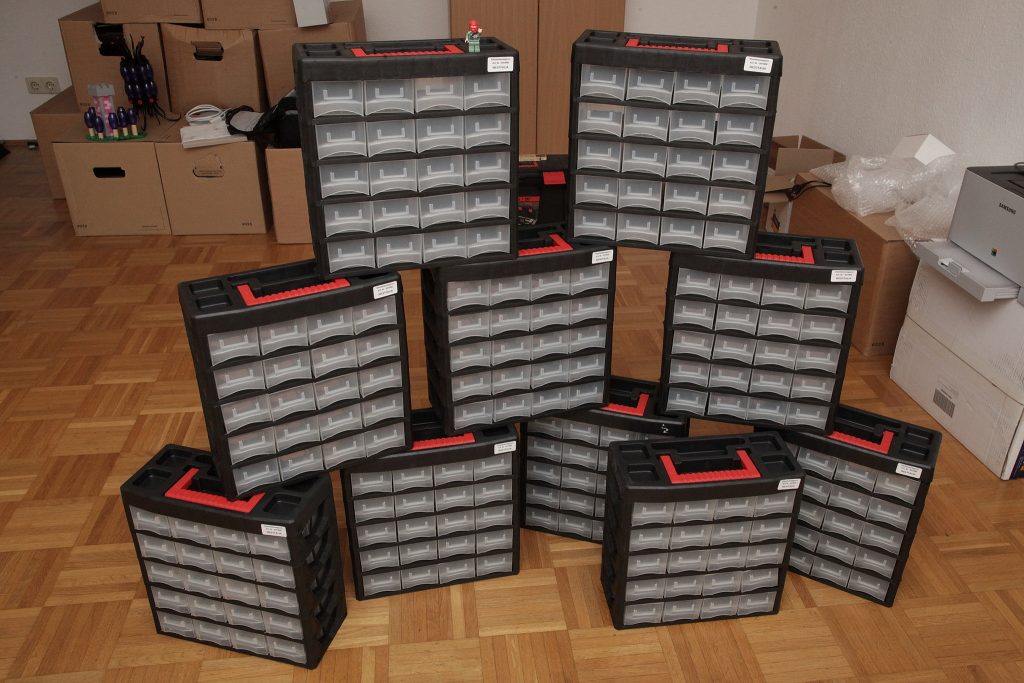Optimisation Tips for Storing Products and Equipment
By optimising your stock storage areas you can increase productivity and reduce the amount of time spent hunting down elusive objects or equipment. Efficient storage can also increase profits and open up opportunities for a nimble response to bargain purchases.
Display and Care of Stock in Storage
Keeping stored stock in good condition is vital, especially if items have a slow turn over and require relatively long term storage:
- Clear storage boxes – you can get these just about everywhere for not much money. One of their big advantages is that you can see what’s inside at a glance. This can be very helpful if stock items are small and you keep slightly different items together. Rows of transparent boxes on shelving units are a convenient way to keep stock items packed away but also on display.
- Archive boxes – these are perfect for storing bookkeeping records or other business documentation that you want to keep orderly. They are like small, portable filing cabinets, and can store papers either in suspension files or flat in the box.
- Cardboard boxes – choose boxes with lids if possible as this makes them sturdier and easier to stack. If you’re storing items that are susceptible to discolouration then choose boxes made from acid free materials.
- Clothes rails and covers – store hanging garments on hangers to help avoid deep creases and retain shape. Clothes rails are inexpensive and can be dismantled to save space when they’re not needed. Invest in garment covers to protect them from dust.
Optimising Storage for Maximum Profit
There’s nothing worse than spotting the bargain of the year but having to pass on it because you don’t have enough stock storage space.
Most rental spaces for stock storage come burdened with long contract times that can eat into profits if you just need extra space for a few weeks. Self storage can provide the answer as facilities offer terms that often run from just a week, making it easy to scale up or down and keep pace with seasonal fluctuations or overstock bargains.
Clearing Space through Virtual Storage
Clear out unnecessary filing cabinets and document storage areas by digitizing as much as possible and using cloud storage instead. With HMRC
becoming more user-friendly through online tax return submission and the acceptance of digital receipt copies, much accounting and document storage space is now redundant.
Use the cleared out areas for stock storage instead, and make space for packing and dispatching from the same location for an efficient and streamlined workflow.
A similar optimization process can be applied to computer and app usage. Choose cloud services for software, such as Google docs or Office 365 that sync all your documents across all your devices. It puts a virtual office in your pocket. It lets you get on with business, access customer records, or check stock levels from wherever you happen to be.
Labeling and Arranging Items in Stock
How you arrange your stock storage area is as important as choosing the correct kind of container and shelving type.
- If space allows, arrange storage on either side of the room with a walkway between the shelves or stacked boxes.
- Put items with the quickest turnaround closest to the door. The idea is to shorten journey time, so you’re not walking further than necessary each time you need to retrieve an item.
- Label boxes clearly. Clear labelling also helps with inventory or stock control as you can include a tally on the outside of the box that you update every time the contents of the box changes.
- Keep an eye on stock items that are not selling. They’re taking up space that could be more profitable so consider holding a sale. Other ideas include leveraging charitable donations or giveaways.
A final tip is to make your storage room a pleasant place. Keep it neat and organised, hang a whiteboard for quick notes to colleagues or yourself, or make a notetaking area on one of your shelves. Also, don’t ignore the vertical space. Above head height is the ideal place for items or equipment you need but don’t use very often.

